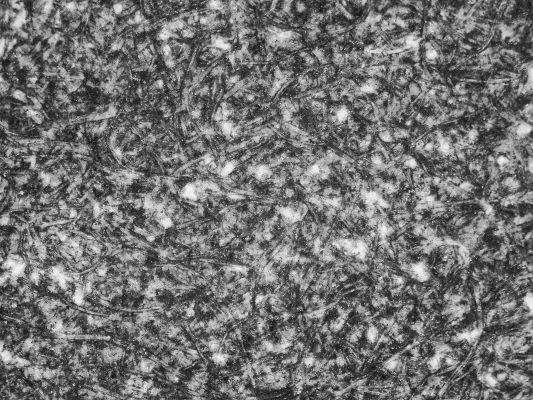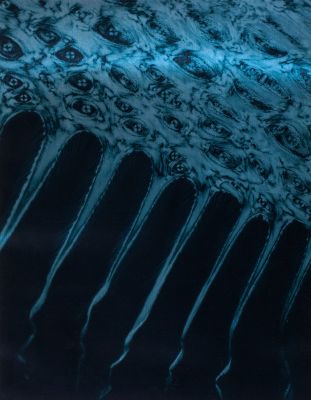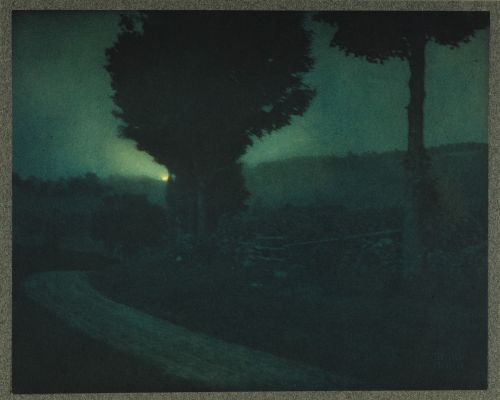
Identification Guide
Photogravure Identification
Unfortunately, a myriad of photomechanical processes have been labeled photogravure, or “gravure”. Sometimes “gravure” refers to the first image ever made by the agency of light, and other times it refers to the coupon section of the local Sunday newspaper. One of these “gravures” is priceless and the other is lucky to make it into the recycling bin. So for the purposes of this site, when we talk about “photogravure” we are referring to what we consider true photogravures–the hand-pulled photogravure (héliogravure au grain fr)*.
A hand-pulled photogravure is just that–made by hand. Every print is inked and pulled by hand on a flat-bed press, and therefore each print is subtly unique. This is the gold-standard of all photomechanical processes. It is the process that William Henry Fox Talbot worked so hard to improve throughout his career, and that Karel Kilč eventually perfected. It is the process that Peter Henry Emerson, Alfred Stieglitz, Alvin Langdon Coburn, James Craig Annan and other great photographers worked tirelessly to master and embraced for some of their greatest works.*
Due to the many variations and incarnations of photomechanical processes, the identification of a hand-pulled photogravure can be difficult. The following guide is a simplified approach intended to help sort it out. It is important to note, however, that it is by no means absolute and in some cases accurate identification requires the opinion of a professional conservator.
Characteristic #1: Under magnification, there is no detectible dot or screen pattern, only random grain.
One of the quickest ways to tell that a print is not a hand-pulled photogravure is to study it under magnification with a loupe or other low power magnifier (8-15X). If a screen pattern or half-tone dot pattern is visible, then chances are you are looking at something made by a machine rather than by hand. Under magnification, a hand-pulled photogravure can be identified by the presence of a highly irregular and randomized grain pattern. The best place to study the fine microstructure is in the mid-tone areas or in places where two different tone boundaries meet. Sometimes the actual grains can be hard to see, as the cells of ink tend to overflow and blend together.
Exception: Collotypes are most often mistaken for photogravures because they share similar characteristics. Although typically collotypes do not have a plate impression and are usually printed on thinner paper, the grain pattern can be difficult to distinguish. The giveaway is a worm-like pattern visible in the middle tones under high magnification. These worm-like shapes are white surrounded by black (see detail below). If you are not sure if the grain on your print is characteristic of a collotype or a photogravure, look for the differential gloss described in number four below. There are at least two early French processes that have a screen pattern – but these are very rare.
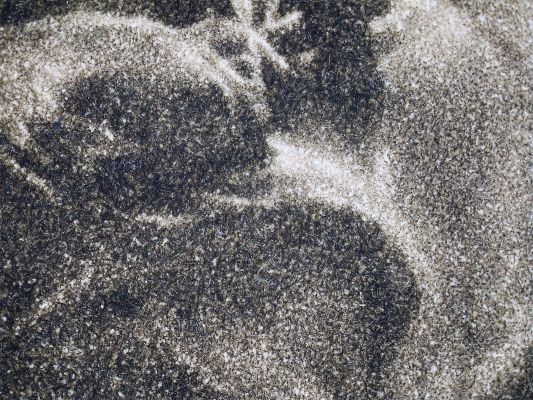
This is a typical hand-pulled photogravure grain pattern viewed at 15X. The grain is soft in nature and often seems lost in the texture of the paper. (Courtesy David Hanson)
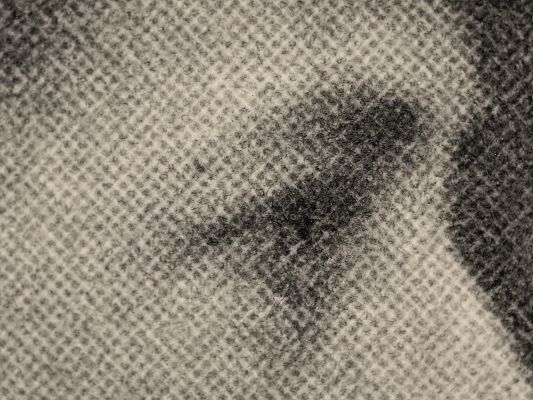
This is the screen pattern of a machine made photogravure magnified by 15X – both rotogravure and sheet fed photogravure exhibit this pattern. (Courtesy David Hanson)
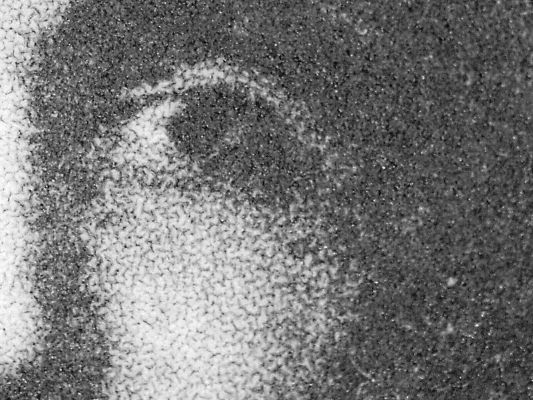
The collotype pattern is the most difficult to distinguish, but upon close examination (15X) white ‘worm like’ patterns can be seen in the midtones. (Courtesy David Hanson)
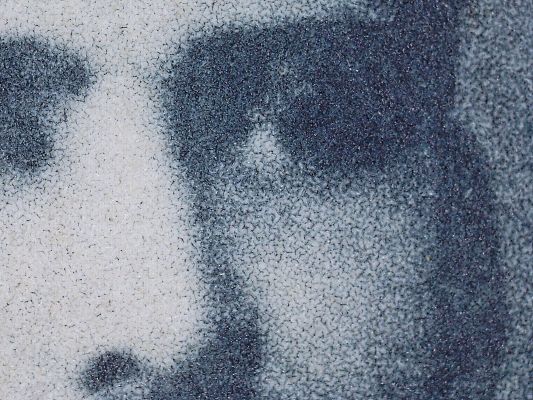
A second example of the collotype reticulated ‘worm like’ grain pattern. (Courtesy David Hanson)
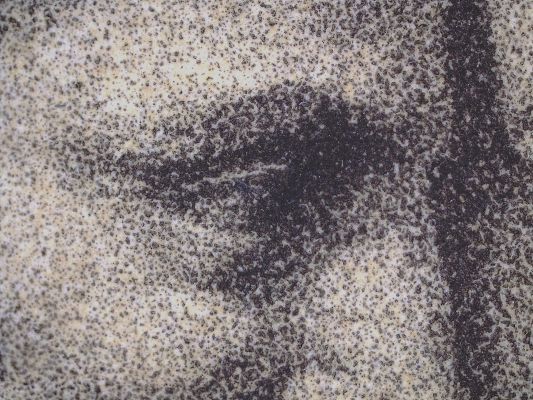
This is the pattern of a photolithograph magnified by 15X. (Courtesy David Hanson)
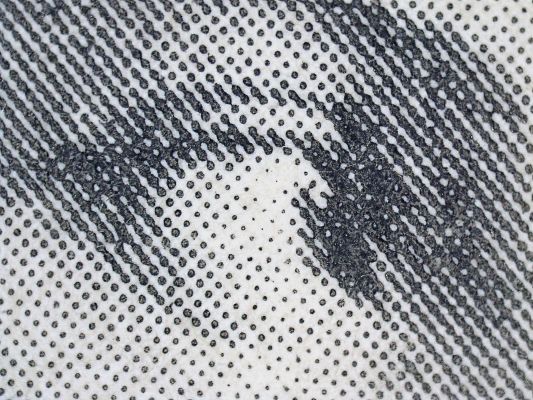
This is a typical halftone screen magnified by 15X. (Courtesy David Hanson)
Characteristic #2: There is a plate impression.
An important visual clue is the presence of a plate impression. Because the ink of a photogravure is transferred from the copper plate to the dampened paper under pressure from the press, the edges of the plate itself create an impression on the paper. A plate impression is often visible unless a thin tissue was used or the image was trimmed. The edges and corners of plate impressions can vary from rounded and beveled to square and crisp.
Exception: Some crafty entrepreneurs made false plate impressions on cheap prints or non-intaglio prints to imitate a higher quality print and increase the value.
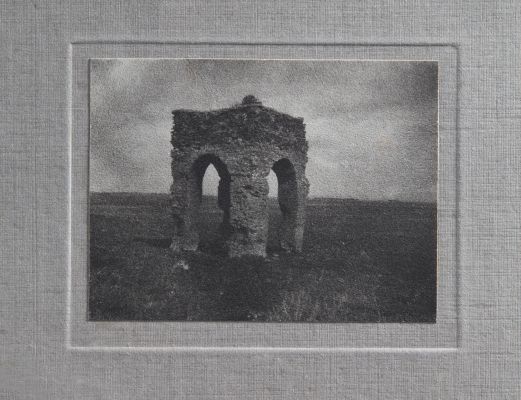
This is false plate impression is made obvious by the edge of the actual print, not to mention the dramatic difference in paper used for the mount.
Characteristic #3: There is no paper texture within the image.
Passing through the press under such pressure will calendar (flatten) the texture of the paper, leaving the areas impressed by the plate smooth. So, if the paper has a texture, the texture will be obliterated in the area of the plate.
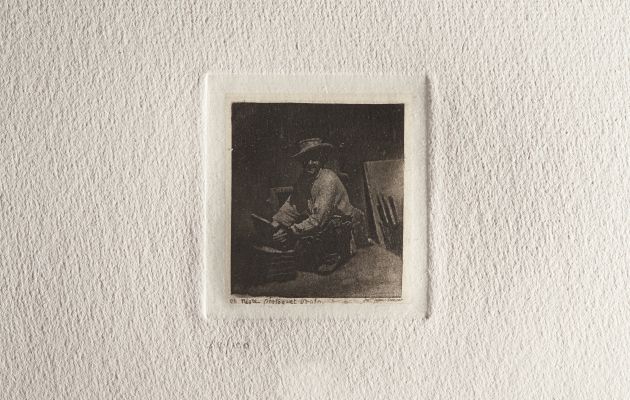
In this example we see a distinct plate impression and the calendared (flattened) paper texture within the margins of the plate.
Characteristic #4: There is a differential gloss observable in reflected light.
The surface of a hand-pulled photogravure is three-dimensional because the areas of deepest shadow are comprised of thick deposits of ink. Sometimes this image relief is perceptible by looking at the print at an oblique angle while reflecting light off of its surface. The best way to do this is in a darkened room in front of a bright window. Hold the print up to the window, parallel to the ground at about the height of your nose. While rocking the print, examine the way the light from the window reflects off of the print surface. The dimensionality of the print (often, but not always) will come alive in the form of differential gloss. Areas of more dense ink (the shadows) will reflect light differently and the print surface may take on a shimmering look. At times the tones in the image may appear reversed. If you cannot see the distinction of tones in reflected light, then it is a strike against the print being a hand-pulled photogravure. On the other hand, if the reflection comes alive, and there is no screen or dot pattern (characteristic #1), then there is a good chance it is.
Exception: Some examples fall into a grey area or are difficult to see in reflected light. Some machine made rotogravure or sheet fed gravures exhibit a strong differential gloss. Our best advice is that this test is used to rule out other processes.
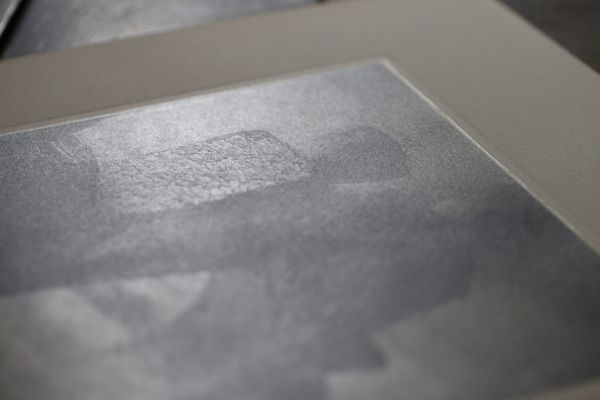
Differential gloss visible in a Paul Strand photogravure.
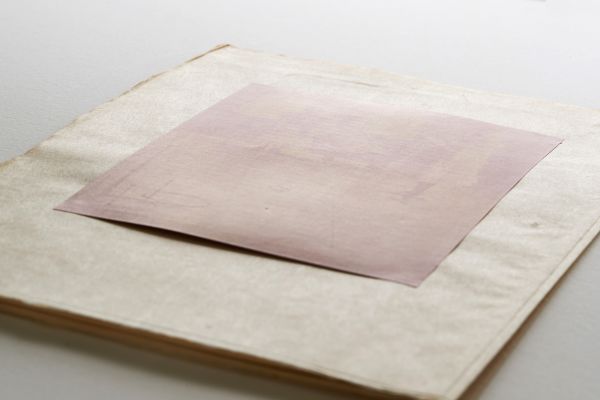
Absence of differential gloss in this Camera Work half-tone.
Characteristic #5: The paper is not coated, shiny or glossy.
When the copper plate passes through the etching press, tremendous pressure is applied to transfer the ink onto the paper. Only certain papers work for this process: usually thick, fibrous papers, but also delicate-yet-strong china or japan tissues. The papers can vary greatly by weight and thickness, and can be made by either a mold or by hand. The papers are usually soft in feel and are principally composed of 100% cotton fiber. You will never see a photogravure on coated paper, regardless if it is a dull coating or a glossy coating. Under magnification paper fibers will be clearly visible.
Exception: Although rare, some hand-pulled photogravures are printed on foil, silk or other materials.
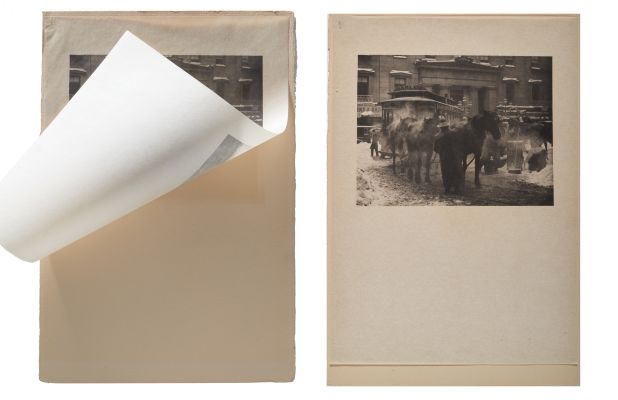
Hand-pulled photogravure on tissue from Camera Work.
Characteristic #6: The verso (reverse) side of the print is blank.
Because of the steps involved in making a true photogravure, the paper is usually printed on one side only. If there is text or images on the verso, it is unlikely that the photogravure was hand-pulled. Most often photogravures are bound separately into books. Text on the page of the photogravure usually appears only in the form of titles and credits and is usually engraved directly onto the photogravure plate.
Exception: Some elaborate projects created photogravure plates combining images and body text.
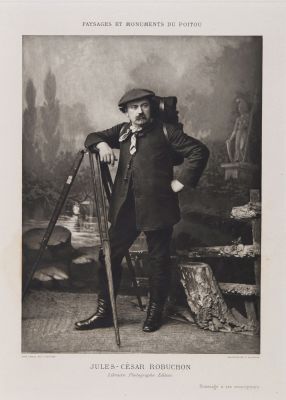
Typical text found within the margins of the plate.
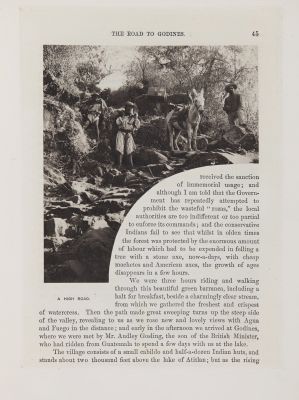
An uncommon example of text etched into the photogravure plate. This example has a faint plate impression that can be best seen in the upper left corner.
Characteristic #7: The print is monotone.
As photogravure prints are simply ink on paper, the ink can be any color. That being said, typically colors were selected to mimic photographic image tones—black, brown, amber, blue, or dark green were most popular for the monochromatic prints.
Exception: Multicolor hand-pulled photogravures are possible, but very uncommon. Various colors can be introduced by printing the plate multiple times in registration, changing the color of the ink with each pass. Prints can also be hand tinted with watercolors. And in a few cases, full color photogravures have been made from multiple copper plates, each etched with a separate color separation.
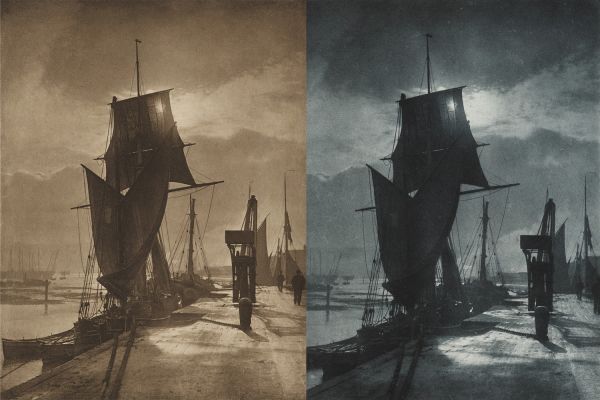
Characteristic monotone photogravure. These two examples were printed six years apart – the sepia image is from 1891 and the blue 1897.
Characteristic #8: There is evidence of Ghosting
Most often seen in books or periodicals containing hand-pulled photogravures, the term refers to the appearance of a “ghost” image on the reverse side of an adjacent printed page of the bound work. Ghosting occurs as a result of oxidation by-products of printer’s ink interfering with the drying of the ink. A ghost can be caused by variables in the ink, paper, production process or ambient conditions (humidity and temperature.) Because hand-pulled photogravures often retain heavy amounts of thick ink, ghosting is more common than with other less ink intensive photomechanical processes including the sheet-fed or rotogravure.
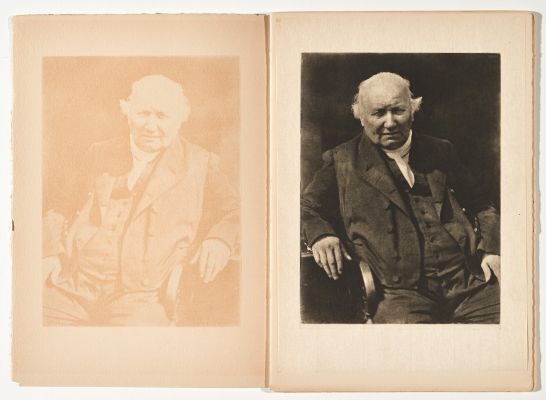
Example of ghosting in Camera Work.
Case Study: Le Roc by G.L. Arlaud
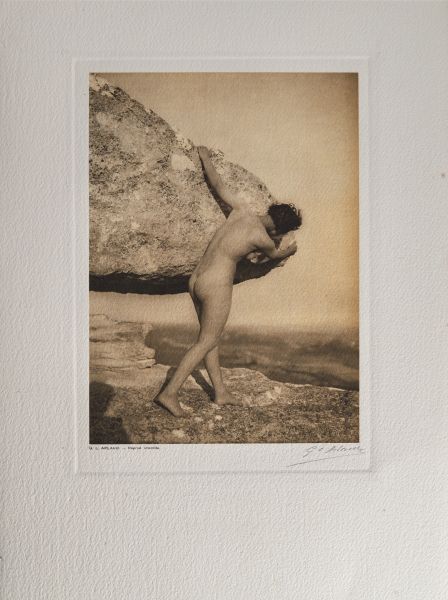
G. L. Arlaud, Le Roc from Vingt Études de Nu en Plein Air 1921.
This photograph by Georges-Louis Arlaud (1869–1944) is from the portfolio Vingt Études de Nu en Plein Air, produced in France in the early 1920s. The portfolio is described in a Christie’s catalog as “containing twelve warm-toned photogravure plates…signed in pencil and with photographer’s printed credit within platemark” (sale 7854). And the National Gallery of Canada describes the portfolio on their site as “containing 20 photogravures.”
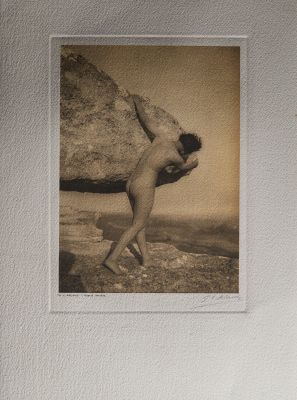
Raking light highlights the plate impression.
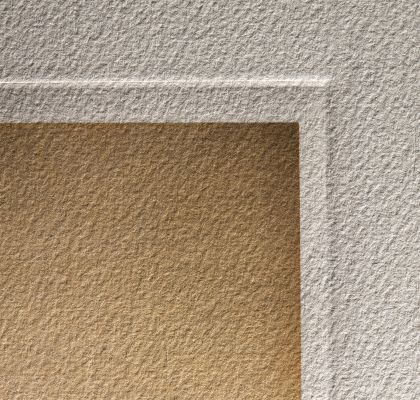
Upon close examination under raking light, paper texture visible on the image indicating the paper was not calendared (flattened) by the press.
At first glance, the work appears to be a hand-pulled photogravure. It has a warm rich tones, is printed on heavy paper, is only printed on one side, has a plate impression, no text, and is signed by the artist in pencil. But on closer examination, we see a distinct paper texture on the image, a screen pattern typical of machine-made prints, and the absence of a distinct differential gloss. So we can safely conclude that, unfortunately, the print is not a hand-pulled photogravure.
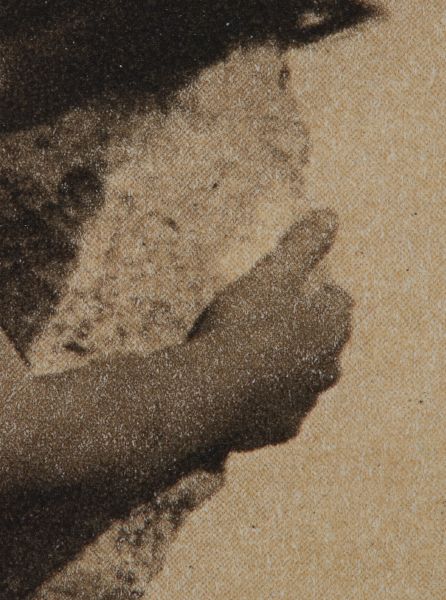
Under low magnification, the screen pattern common in mechanized prints is easily observed.
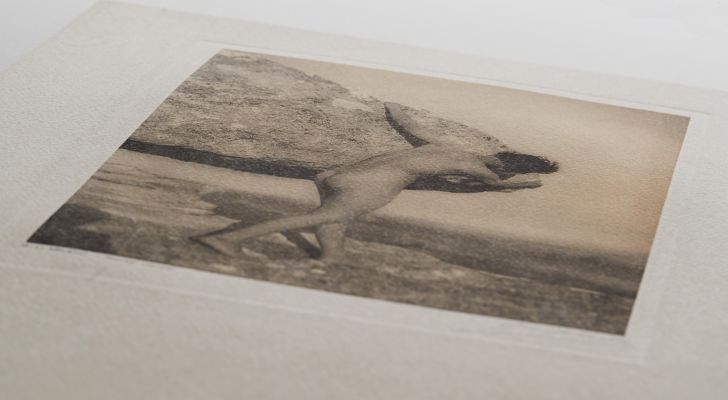
The differential gloss test is not conclusive. No shimmer is observed.
References
Still need help? For a deeper dive into the identification of photogravures and many of the other photomechanical processes check out:
David Hanson’s Checklist of Photomechanical Processes and Printing 1825 – 1910
The Atlas of Analytical Signatures of Photographic Processes at the Getty Conservation Institute
Benson, Richard. The Printed Picture. New York: Museum of Modern Art, 2008.
Crawford, William. The Keepers of Light: A History and Working Guide to Early Photographic Processes. New York: Morgan & Morgan,
Gascoigne, Bamber. How to Identify Prints. London: Thames & Hudson, 1988.
*A hand-pulled photogravure is the product of a continuous-tone intaglio process in which an aquatinted copper plate is etched to various depths according to the original photograph’s tonality. The deeper the tone of the image, the deeper the copper is etched. The aquatint, a random grain pattern made from melted rosin dust (asphaultum) or, in modern times, an exposed random stochastic pattern from a separate sheet of film, creates a texture to hold the ink. Each time a print is made, the etched copper plate is inked and wiped by hand and pressed into paper under tremendous pressure. The official name for this method is the “Talbot-Kilč hand-pulled copper-plate photogravure” and it is the primary method used by artist-photographers to make original prints. William Crawford labels this process ‘grain gravure’ due to the use of an aquatint grain instead of the screen necessary for machine made gravures.
